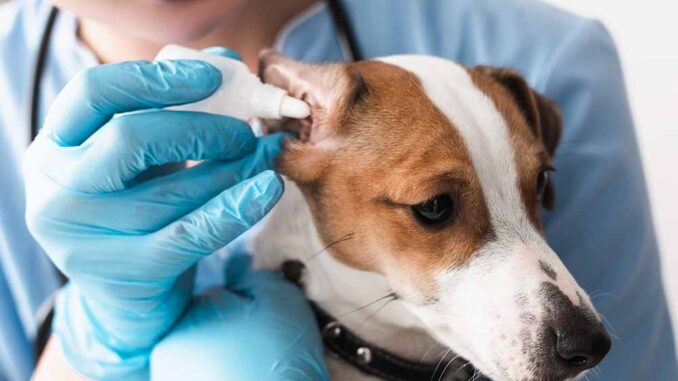
This article was updated on January 7th, 2024
A dog’s ears present a lot of questions for their owners, many of which revolve around ear wax. There are many aspects of dog ear wax that are normal and many that aren’t. So, let’s break down what normal dog ear wax should look like and when to suspect a problem. To help in the process, we have designed a new dog ear wax color chart.
What Is a Normal Color for Dog Ear Wax?
If you take a look into a healthy dog ear, you’ll notice a thin coating of a pale yellow substance. That’s normal ear wax. There typically isn’t a lot of it, although ear wax production can vary by dog.
Here are the signs of normal ear wax in dogs:
- The ear wax should not have an odor,
- The ear wax should not be dark or bloody,
- The ear wax should be pale yellow,
- The surrounding ear should be a nice, calm pink.
Dog Ear Wax Color Chart [With Colors Indicating a Medical Issue]
Our veterinarians have created a color chart to summarize the different colors of ear wax in dogs, along with their meanings [See image below]:
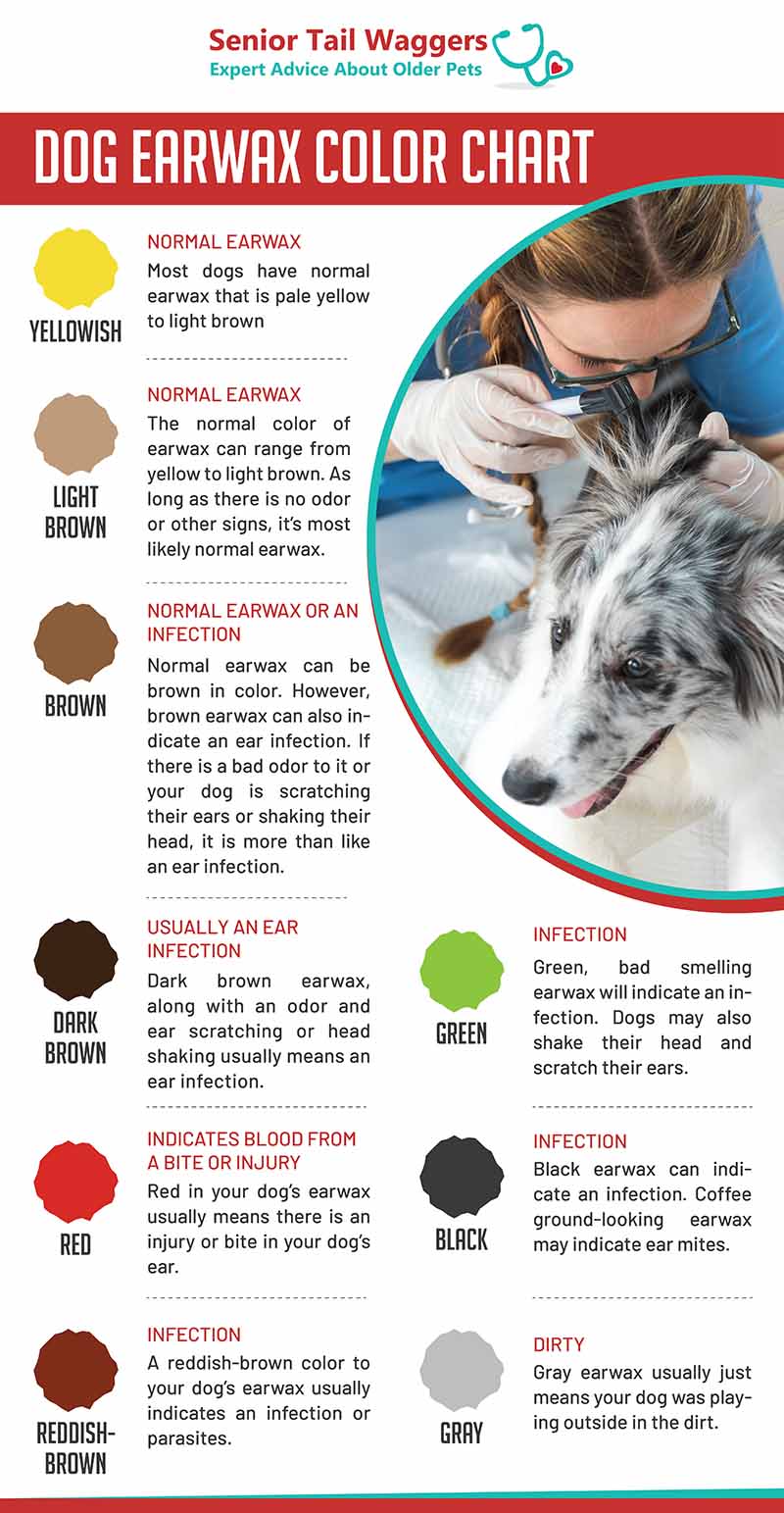
Below is a text table summarizing this information. In the next sections, we will review signs that your dog has an ear issue, and what to do about it!
Dog Ear Wax Colors and What They Mean (Text Table)
| Yellowish | Normal | Most dogs have normal ear wax that is pale yellow to light brown |
| Light brown | Normal | The normal color of ear wax can range from yellow to light brown. As long as there is no odor or other signs, it’s most likely normal ear wax. |
| Brown | Normal or infection | Normal ear wax can be brown in color. However, brown can also indicate an ear infection, if there is bad odor or if your dog is scratching their ears or shaking their head. |
| Dark brown | Usually ear infection | Dark brown ear wax, along with an odor and ear scratching or head shaking usually means an ear infection. |
| Red | Indicates blood from injury | Red in your dog’s ear wax usually means there is an injury or bite in your dog’s ear. |
| Reddish-brown | Infection | A reddish-brown color to your dog’s ear wax usually indicates an ear infection or parasites. |
| Green | Infection | Green, bad smelling ear wax will indicate an ear infection. Dogs may also shake their head and scratch their ears. |
| Black | Infection | Black ear wax can indicate an infection. Coffee ground-looking ear wax may indicate ear mites. |
| Gray | Dirty | Gray ear wax usually just means your dog was playing outside in the dirt. |
Example Problematic Ear Wax
Pictured below is an abnormal brown discharge in a dog’s ear, the result of an ear infection: infections can lead to abnormal earwax due to increased inflammation and irritation in the ear canal. Excessive buildup of earwax can block the ear canal, which can further worsen the infection.
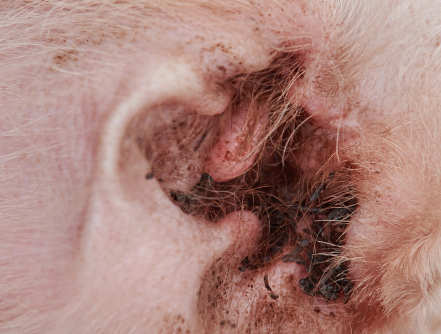
Signs that your dog’s ears or earwax are an issue
Abnormal ear wax can come in many different colors. The wax may be:
- brown,
- black,
- red,
- extra greasy,
- dry and crumbly and
- smell bad.
Each change in ear wax may mean something different with issues ranging from a bacterial or fungal infection to parasites.
You may also notice that the inside of your dog’s ear can become:
- red,
- swollen,
- or even bloody
Dogs with ear infections or parasites may also:
- shake their head,
- scratch their ears, or
- not want their ears touched
How to Prevent Problematic Ear wax
If your dog is a repeat offender to ear infections or excessive earwax, regular ear cleaning will become your best friend’s best friend.
If your dog has normal earwax and no other signs, try not to disturb the delicate balance in the ear. Cleaning ears that don’t necessarily need it may cause a disruption that leads to ear infections or excessive earwax down the road.
Some dogs will do well with scheduled ear cleanings, say once or twice a week to prevent earwax buildup and infections. Others may just need it after baths, swimming, or a day out in the rain or snow. Speak to your veterinarian about what cleaning schedule is best to prevent your dog’s recurrent earwax problems.
Common problems associated with ear wax
Most of the time, a dog’s self-cleaning system in their ears works well to keep the ears healthy and a dog’s hearing top-notch. However, there are times when ear wax can actually cause problems in a dog’s ears.
Certain dog breeds and health conditions can cause excessive ear wax production and build-up that may cause:
- pain,
- difficulty hearing,
- ear infections, or
- even attract parasites.
Dogs with long ear canals, think of Basset Hounds, may have difficulty properly draining ear wax. Excessive hair in the ears in breeds like Poodles can form a sort of dam that blocks ear wax from leaving the ear. Skin folds found in Bulldog breeds can have the same effect. There are even some breeds like Cocker Spaniels that carry a genetic predisposition to producing excessive ear wax.
All of these conditions make it more difficult to normally rid the ear of ear wax and the irritants that it traps. In some of these cases, you’ll not only see excessive ear wax, you may also notice a change in the color and odor that would indicate an infection. You may also notice that your dog tilts or shakes their head, scratches at their ears, or doesn’t want their ears touched when their having a problem.
Causes of Abnormal Dog Ear Wax
If your dog has some abnormal ear wax, your next step is to figure out why. Finding the exact cause will take looking at a dog’s other signs and possibly some veterinary diagnostics:
- Excessive production/improper drainage: If you have a long- or hairy-eared dog, chances are their excessive ear wax is due to not draining properly. The ear canal is either just too long for the wax to flow out or it’s being blocked by hairs or skin folds. If this is the case, you may have to regularly clean the ears to prevent other complications. On the other side of this, your dog may produce so much ear wax that it won’t drain properly. Same thing goes, clean the ears regularly.
- Ear infections: Bacteria and yeast like dark, moist areas which makes the ears the perfect place to set up shop. Ear infections are more common in dogs with long or heavy ears that don’t let a lot of air into the canals. They also tend to occur after swimming, bathing or an outing in the rain or snow. If your dog has brown, green, or black ear wax with a bad odor and are shaking or tilting their head or scratching their ears, see your veterinarian. Prescription cleaners and ointments may be necessary to clear up an ear infection.
- Ear mites: While more common in cats, dogs can get ear mites. These are little bugs that live in the skin of the ear canal and feed on blood and earwax. They often create a black, coffee ground-looking ear wax and very itchy ears. Your dog will be rubbing their head on the carpet, furniture, and asking for ear rub after ear rub. Veterinarians will diagnose them by finding the little critters under the microscope and treating with an anti-parasiticide.
Is it Ear Wax or Ear Mites?
Determining whether your dog’s aural discharge is due to an ear infection or ear mites can be tricky without veterinary diagnostics. Both issues will show up with brownish discharge and itchy ears, however, ear mites will cause an intense, insatiable itch.
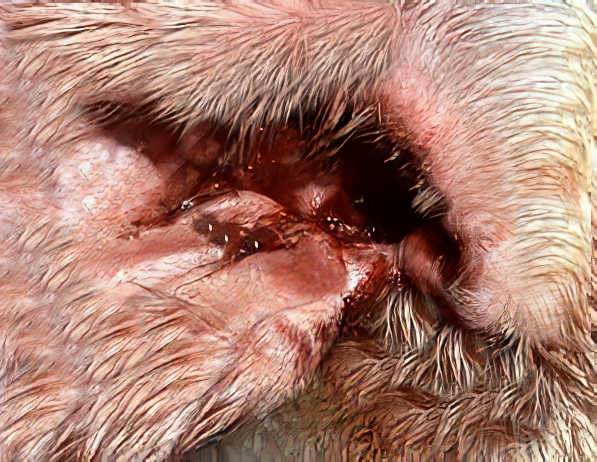
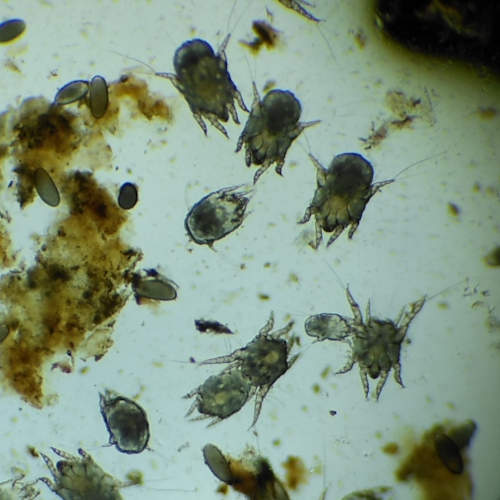
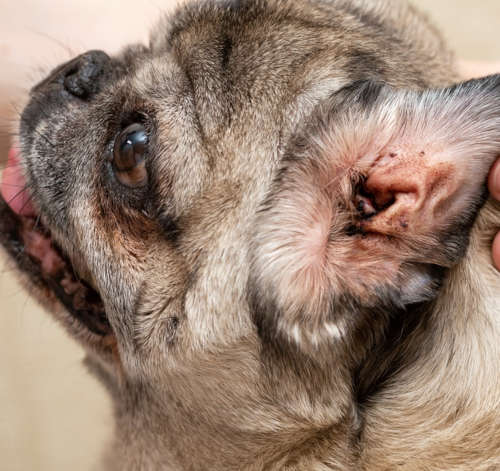
The discharge also tends to look crumbly and granular, like coffee grounds. Ear infections, on the other hand, tend to have a greasier, gooier texture. Ear mites may also cause small, red bumps to pop up on the outside of the ear, face, and neck.
The only definitive way to diagnose ear mites is to get a small sample and view the adult mites or eggs under a microscope. A veterinarian will be able to do this quickly and easily and get your dog the right treatment.
Read More About Dog Ears:
 Dog Ear Flap Issues: Cysts, Lumps & Bumps [With Pictures] - As a veterinarian, I often come across various ear flap conditions, which can be quite concerning for pet owners. However,… [...]
Dog Ear Flap Issues: Cysts, Lumps & Bumps [With Pictures] - As a veterinarian, I often come across various ear flap conditions, which can be quite concerning for pet owners. However,… [...] 6 Top Causes of Red Rash or Red Spots in Dog’s Ear - Most of us have a special affection for our dog’s ears. They’re velvety soft and either short and perky or… [...]
6 Top Causes of Red Rash or Red Spots in Dog’s Ear - Most of us have a special affection for our dog’s ears. They’re velvety soft and either short and perky or… [...] Home Remedies for Dog Ear Infections [Vet Approved] - If your dog is scratching their ears or shaking their head, they may be bothered by an ear infection. Skin… [...]
Home Remedies for Dog Ear Infections [Vet Approved] - If your dog is scratching their ears or shaking their head, they may be bothered by an ear infection. Skin… [...]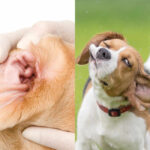 Dog Shaking Head But Ears are Clean? Our Vet Explains Top Causes - It’s common for dogs to normally shake their heads and flap their ears, especially after swimming, baths, when they’re excited,… [...]
Dog Shaking Head But Ears are Clean? Our Vet Explains Top Causes - It’s common for dogs to normally shake their heads and flap their ears, especially after swimming, baths, when they’re excited,… [...]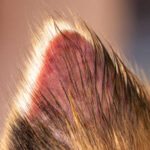 Dog Has Scabs On Ears: Top Causes & Vet Advice - In this article, our experienced veterinarian Dr. Chyrle Bonk walks you through common causes of scabs on a dog’s ears,… [...]
Dog Has Scabs On Ears: Top Causes & Vet Advice - In this article, our experienced veterinarian Dr. Chyrle Bonk walks you through common causes of scabs on a dog’s ears,… [...] Yeast Ear Infections in Dogs – With Pictures & Vet Advice - Yeast ear infections are a common health condition in our canine companions, often causing: intense ear scratching, black or brown… [...]
Yeast Ear Infections in Dogs – With Pictures & Vet Advice - Yeast ear infections are a common health condition in our canine companions, often causing: intense ear scratching, black or brown… [...] Dog Ear Yeast Infection or Ear Mites? Our Veterinarians Explain - As pet owners, we want our dogs to be healthy from head to toe. But one area that often gets… [...]
Dog Ear Yeast Infection or Ear Mites? Our Veterinarians Explain - As pet owners, we want our dogs to be healthy from head to toe. But one area that often gets… [...] 9 Best Dog Ear Cleaning Solutions, According to a Vet - Not every dog is going to require regular ear cleaning. In fact, overcleaning healthy ears can upset the normal balance… [...]
9 Best Dog Ear Cleaning Solutions, According to a Vet - Not every dog is going to require regular ear cleaning. In fact, overcleaning healthy ears can upset the normal balance… [...] 5 Most Common Dog Ear Infections [with images] & What To Do - Ear infections are very commonly seen in dogs. In our veterinary practice, I see about 5 dogs each day with… [...]
5 Most Common Dog Ear Infections [with images] & What To Do - Ear infections are very commonly seen in dogs. In our veterinary practice, I see about 5 dogs each day with… [...]Disclaimer: This website's content is not a substitute for veterinary care. Always consult with your veterinarian for healthcare decisions. Read More.



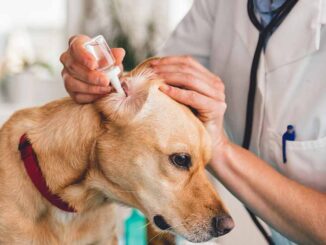
Be the first to comment